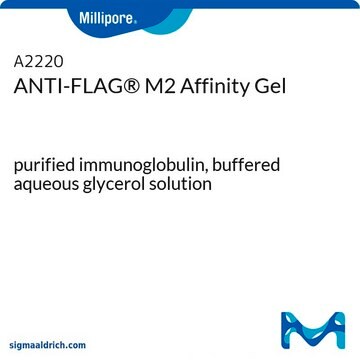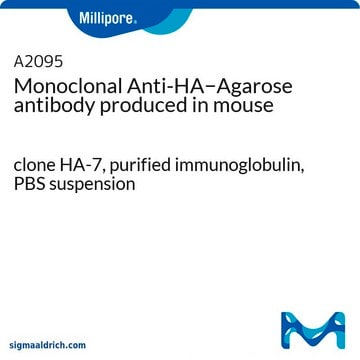11815016001
Roche
Anti-HA Affinity Matrix
from rat IgG1
Sinônimo(s):
affinity matrix, anti-ha
About This Item
Produtos recomendados
fonte biológica
rat
Nível de qualidade
conjugado
agarose conjugate
forma do anticorpo
purified immunoglobulin
tipo de produto de anticorpo
primary antibodies
clone
3F10, monoclonal
Formulário
slurry
embalagem
pkg of 1 mL (settled resin volume)
fabricante/nome comercial
Roche
Isotipo
IgG1
sequência de epítopo
YPYDVPDYA
capacidade
2-8 nmol/mL binding capacity
temperatura de armazenamento
2-8°C
Categorias relacionadas
Descrição geral
Especificidade
Imunogênio
Aplicação
- Western blotting using the Anti-HA antibody
- Silver staining (or similar protein stain)
- In coimmunoprecipitation.[1]
Características e benefícios
- Achieve enhanced specificity and reduced cross-reactivity of Anti-HA High Affinity.
- Use nondenaturing conditions for elution of your HA-tagged protein of choice.
- Purify even rarely expressed HA-tagged proteins.
- Highly specific to YPYDVPDYA.
- Suitable for purification of proteins containing HA-epitop as N-terminal, C-terminal or internal fusion.
- Applicable with crued cell extracts from mammalian, bacterial and yeast expression systems.
Qualidade
forma física
Nota de análise
Outras notas
Não está encontrando o produto certo?
Experimente o nosso Ferramenta de seleção de produtos.
Código de classe de armazenamento
12 - Non Combustible Liquids
Classe de risco de água (WGK)
WGK 1
Ponto de fulgor (°F)
does not flash
Ponto de fulgor (°C)
does not flash
Escolha uma das versões mais recentes:
Já possui este produto?
Encontre a documentação dos produtos que você adquiriu recentemente na biblioteca de documentos.
Os clientes também visualizaram
Protocolos
Anti-HA Affinity Matrix Protocol & Troubleshooting
Nossa equipe de cientistas tem experiência em todas as áreas de pesquisa, incluindo Life Sciences, ciência de materiais, síntese química, cromatografia, química analítica e muitas outras.
Entre em contato com a assistência técnica











